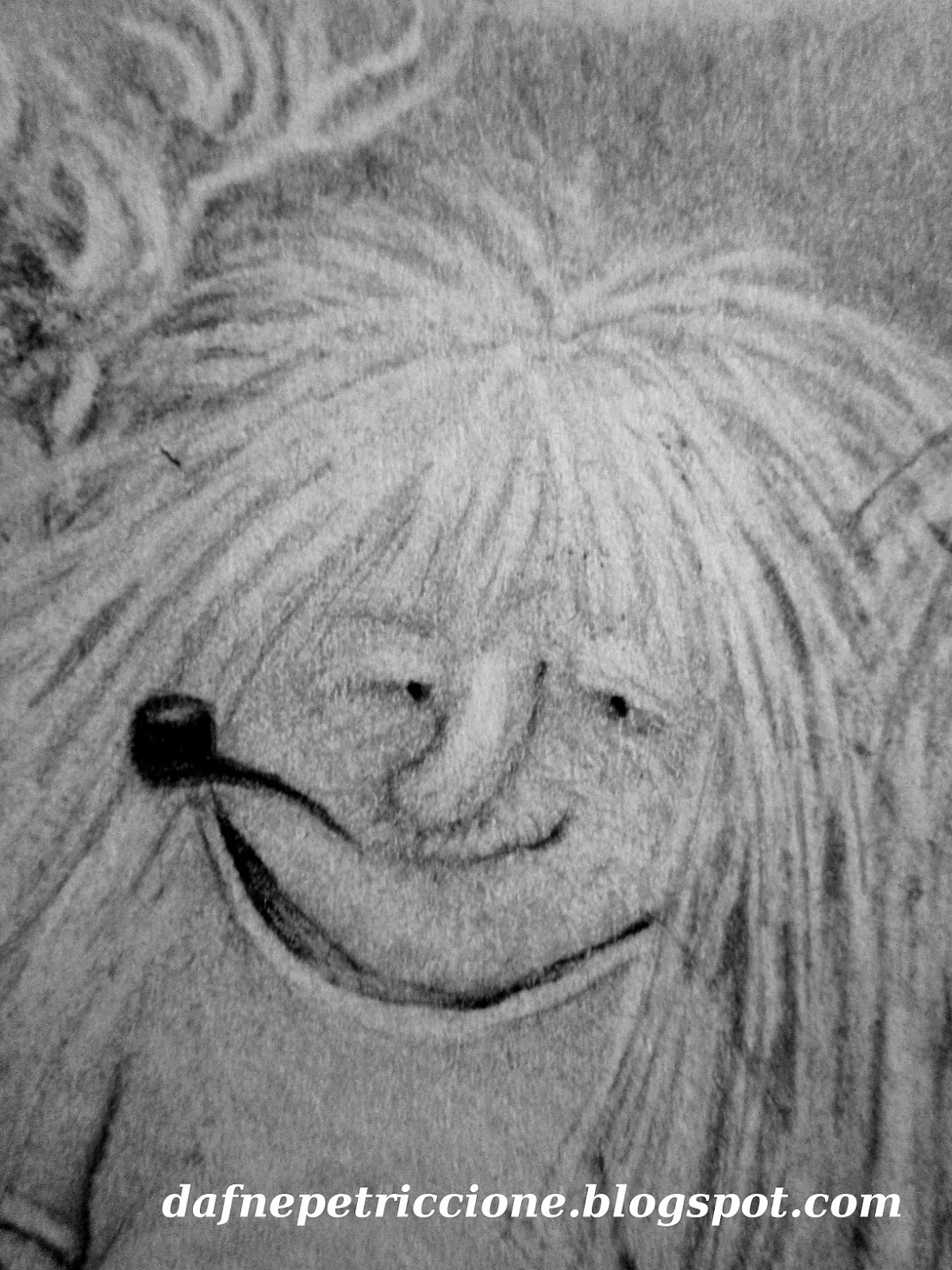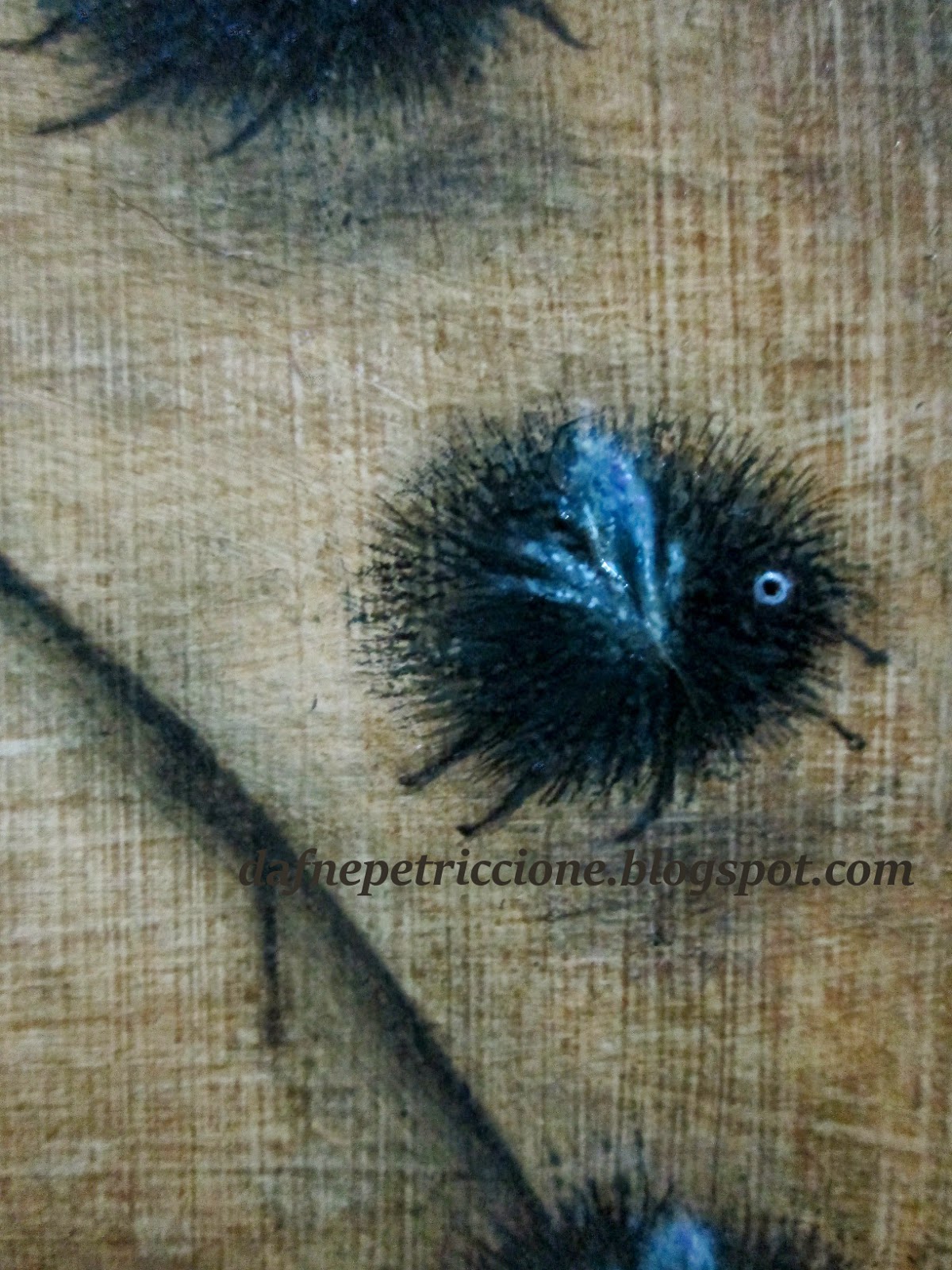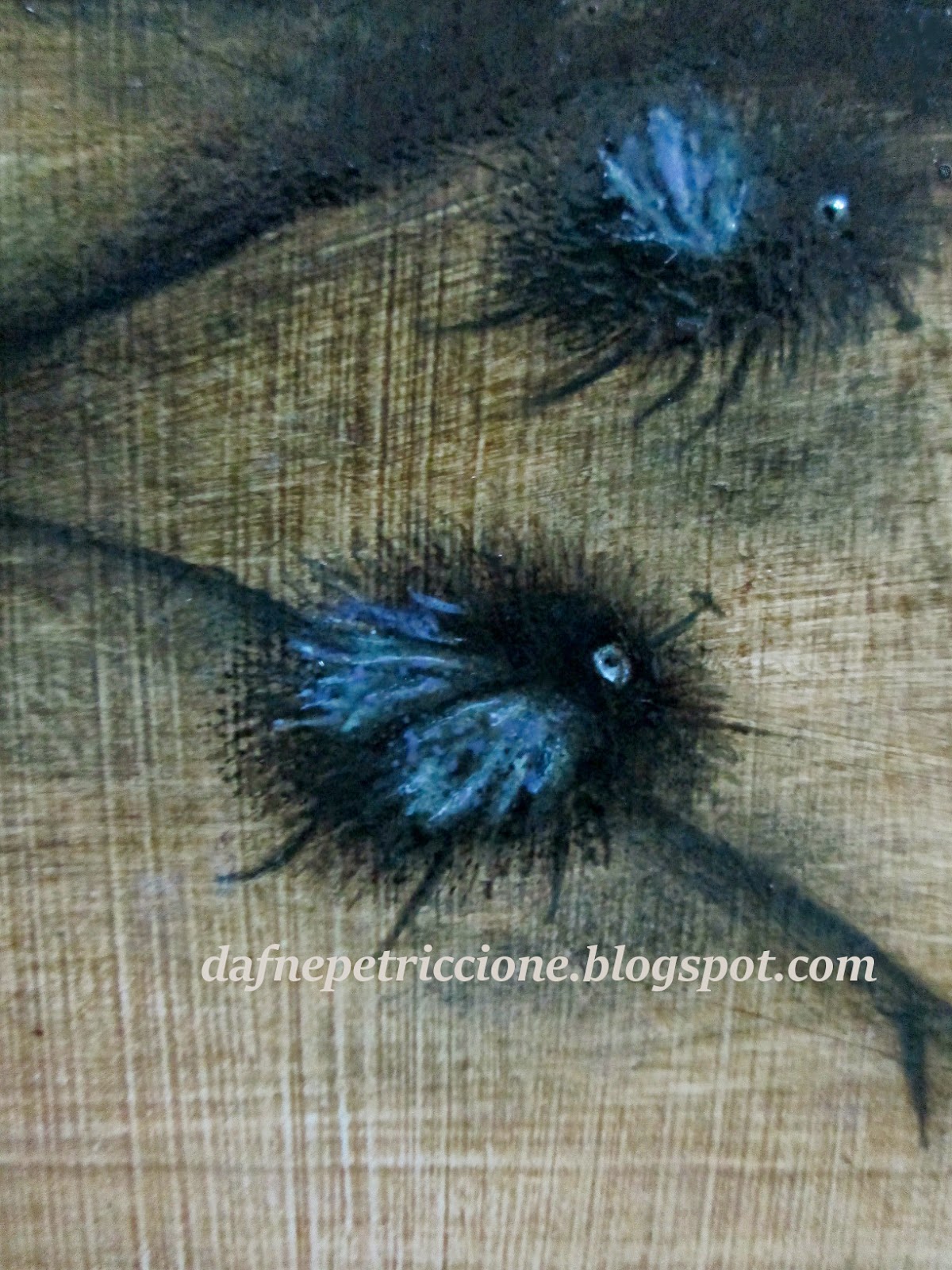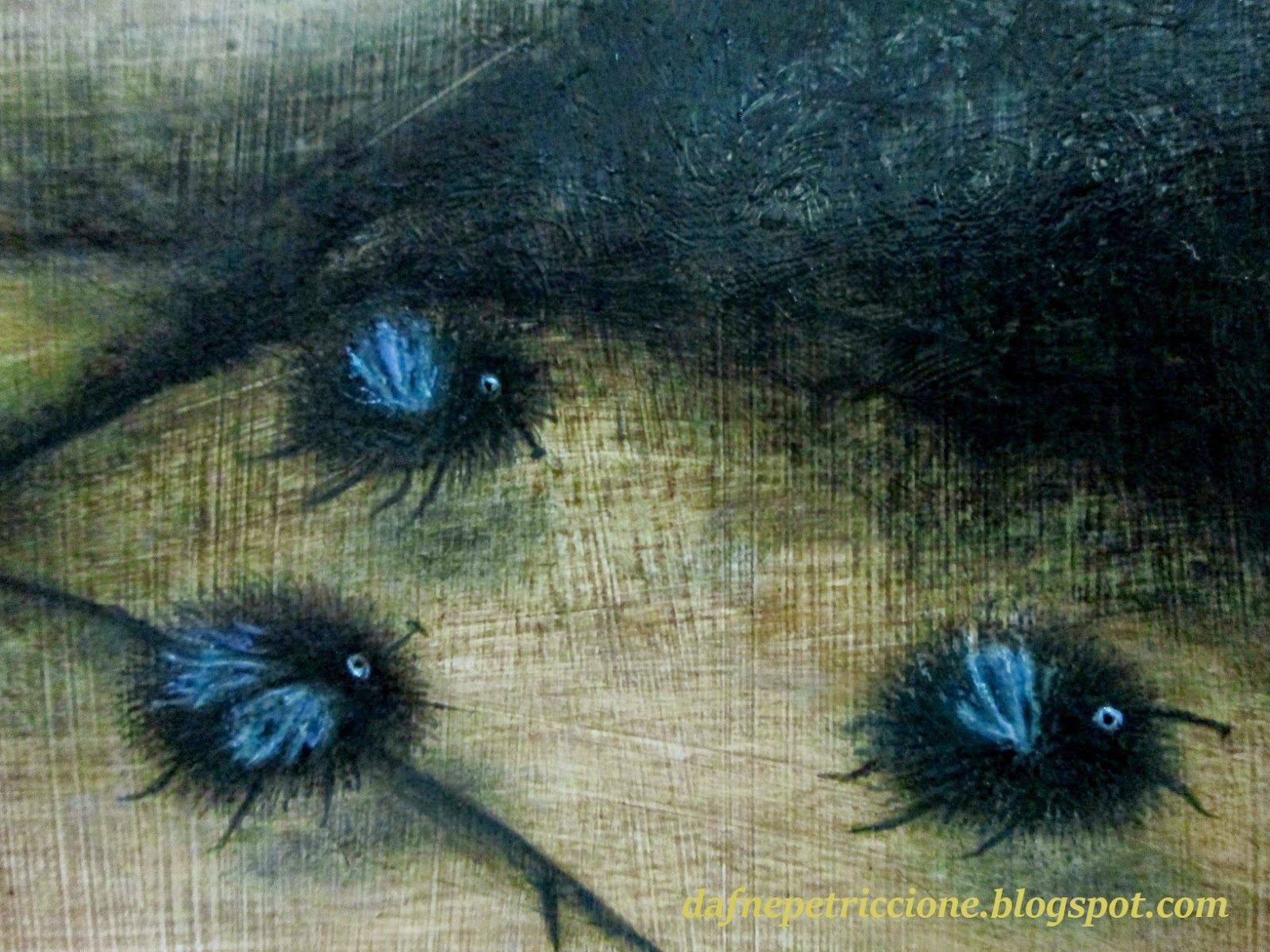Un’altra deliziosa collaborazione:
Maurizio Mei autore dell’incalzante brano ed amico.
Ilaria Petriccione paziente traduttrice del testo nonché mia
sorella.
Io, autrice del b/n in fondo.
A4 , matita su carta liscia.
Buona Lettura !
Another
exquisite collaboration:
Maurizio
Mei author of the thrilling tale, and dear friend.
Ilaria
Petriccione patient translating of the text, and my sister.
And me,
author of the black and white illustration at the bottom.
A4, pencil
on smooth paper.
Enjoy !
'' Le mosche nella testa ''
Nel primo pomeriggio di una bella giornata di inizio estate, un uomo scendeva lungo un sentiero nella faggeta. Aveva uno zaino, gli occhiali, un berretto militare con la visiera e un gilet da pescatore verde scuro, dalle molte tasche. In mano portava una specie di retino da farfalle ma più corto e robusto, col sacco di tela bianca e pesante. Era un uomo sulla sessantina, perito chimico precocemente in pensione ed entomologo dilettante. Era stato sposato, non aveva figli e dal divorzio viveva solo. Il suo lavoro in una piccola industria gli aveva dato uno stipendio e anche qualche piccola soddisfazione, ma la sua passione, la sua unica vera passione, erano gli insetti, i coleotteri in particolare, che collezionava fin da quando era bambino. Ritornava appunto da un’escursione a caccia di insetti in quelle montagne.
Le ore, le giornate passate a raccogliere in campagna, che da quando era andato in pensione non erano più limitate ai fine settimana, erano ore e giornate quasi sempre felici. Concentrato nella caccia, cercando l’emozione della scoperta di una preda insolita, nuova, si perdeva nei boschi, nei campi, lontano dalla città, dalle preoccupazioni e dalle seccature di tutti i giorni, dalla gente, dalle chiacchiere inutili, dai colleghi di lavoro… lontano insomma, almeno per qualche ora, dal mondo degli adulti, un mondo mai del tutto frequentato da un entomologo dilettante, anche se perito chimico sulla sessantina e precocemente in pensione.
Negli anni, a forza di raccolte, di scambi, di acquisti, aveva messo su una ricca collezione, che occupava ben curata e molto gelosamente custodita alcuni armadi di legno in una stanza speciale della casa. Ci lavorava quasi ogni sera, preparando e identificando esemplari, aggiungendoli agli altri meticolosamente preparati nelle scatole dal coperchio di vetro. In quegli armadi c’era il lavoro paziente e segreto di una vita: la sua creatura, il suo rifugio. Gli insetti secchi, spillati, simmetrici, erano allineati in lunghe file o in schiere compatte e regolari secondo una gerarchia che considerava specie, provenienza geografica, gruppi di variazioni cromatiche e creavano in ogni scatola, insieme a quegli esemplari che invece occupavano solitari o in piccoli gruppi spazi tutti loro, una specie di quadro astratto, una partitura silenziosa con un ordine, un’armonia, un ritmo in cui lui si riconosceva e che, spesso, si soffermava a contemplare. Ogni specie che entrava per la prima volta in suo possesso trovava un suo posto nell’insieme, andava ad inserirsi in un quadro. Ogni nuova rarità, a volte sognata ad occhi aperti e desiderata per anni, rendeva la collezione ancora più preziosa.
Quella mattina la raccolta non era stata né abbondante né particolarmente soddisfacente. Aveva trovato pochi esemplari e di specie piuttosto banali. Aveva sollevato sassi, strappato cortecce, spaccato pazientemente pezzi di legno morto, aveva battuto le fronde basse degli alberi con un bastone raccogliendo quello ne che cadeva su un telo bianco che poi esaminava con una lente. Aveva falciato le erbe alte lungo il sentiero e nelle radure con l’apposito retino, cercando poi di individuare e catturare, nella massa brulicante di moschini, cavallette, cimici, ragni, opilioni e altri esseri con molte zampe che ogni volta si ammassava in fondo al sacco, quei pochi coleotteri interessanti che c’erano capitati. Aveva scoperchiato e frugato nelle merde di vacca nei prati in alto per cercare gli scarabei coprofagi, e più tardi si era addirittura ricordato di lavarsi le mani in un fontanile prima di sedersi su un sasso a mangiare il panino che si era portato per pranzo. Con i pochi insetti raccolti, addormentati e poi uccisi con l’etere in provette di plastica, scendeva dunque lungo il sentiero diretto al fondovalle e alla macchina che lo aspettava in una piazzola a poca distanza sulla provinciale, dove l’aveva lasciata al mattino per iniziare la salita sull’altro versante.
Il sentiero, ripido e scomodo, non portava in nessun luogo particolarmente interessante per un escursionista ed era poco frequentato. In mezzo alla settimana, poi, non ci passava praticamente mai nessuno, nemmeno i vaccari che ogni tanto andavano a controllare le bestie brade in alto nella valle. Faceva piuttosto caldo e l’entomologo, ancora agile ma piuttosto in sovrappeso, sudava molto e cominciava a sentirsi un po’ stanco. Non vedeva l’ora di cambiarsi la camicia e di togliersi gli scarponi. Il gilet era zuppo sulla schiena sotto lo zaino e orlato di bianco alle ascelle, le ginocchia indolenzite. Era ormai a qualche centinaio di metri dalla fine del sentiero e dalla strada, la faggeta si era mutata prima in un bosco misto e poi in una macchia folta di alti cespugli spinosi, querce e noccioli e in questo intrico il sentiero adesso scendeva ancora più ripido, sassoso e con strette svolte. Fece una breve sosta per battere le fronde di una piccola quercia, ma era appena ripartito che qualcos’altro attirò la sua attenzione. Nell’aria calda e quasi ferma c’era un odore acre, il tanfo di un animale morto. Ancora una decina di metri e il tanfo era più forte che mai. “C’è una carogna” pensò, “e pure grossa.” Sono molti gli insetti che frequentano le carogne, molti sono belli e, soprattutto, si trovano soltanto lì. L’odore atroce sembrava provenire da qualche parte nel pendio sotto di lui, dove tra i cespugli si intravvedeva un possibile varco. L’entomologo si tolse lo zaino per muoversi meglio e lo posò ritto sul sentiero, si aggiustò gli occhiali sul naso, tirò fuori la bottiglia dell’acqua, bevve un po’. “Sarà una vacca morta” pensò “andiamo a vedere!” e, prese in mano le pinzette entomologiche che portava appese al polso con un cordino per non perderle, si fece strada tra i cespugli nella scarpata.
Non era una vacca morta. Sembrava una grossa bambola di gomma, disarticolata, supina, di colore chiaro e indefinibile, qua e là vagamente bluastro… Non aveva scarpe né calze, ma le mutande erano ancora al loro posto, bianche come il reggiseno, mentre quel che rimaneva degli altri indumenti, una maglietta sottile e una camicia azzurra sporca di terra, strappata e macchiata di scuro, era arrotolato in su oltre la pancia gonfia e tesa, a nascondere la testa, le spalle e le braccia gettate in alto e all’indietro. Scendendo goffamente per la scarpata ci era quasi finito sopra, alzando un vortice sonoro di mosche verdi e blu, molto seccate per l’intrusione. “Oh Cristo! Oh Cristo!”. La faccia – per fortuna!, riuscì a pensare – coperta dai vestiti non si vedeva. “Occristodiddìo!”. La puzza era insostenibile. Gli sembrava che ci fossero mosche impazzite anche nella sua testa. Per un lungo minuto almeno rimase impietrito lì nella fratta, con le gambe molli, fissando quell’orrore senza voler capire davvero, poi gradualmente i suoi occhi iniziarono a cogliere dei dettagli: una scarpa a poca distanza dal corpo, le dita dei piedi stranamente rattrappite, le gambe tutte graffiate, una ferita profonda e slabbrata su un fianco, popolata di bigattini... e proprio vicino alla ferita, un insetto che si arrampicava sulla pelle tesa, un coleottero necrofago, grosso, nero con quattro macchie di un rosso aranciato, simmetriche, che sulle elitre lucide delimitavano una specie di croce scura: una zampa dopo l’altra, saliva sul ventre del cadavere, camminando tranquillo ma deciso, con il capo sollevato e le antenne tese e vibranti.
Una parte del suo cervello riprese a funzionare in automatico… quello era un coleottero che non aveva mai visto prima, probabilmente un Necrophorus, ma dall’aspetto particolare, troppo lucido e con le macchie disposte in maniera anomala, e troppo grosso, molto più delle specie a lui familiari e che ci si poteva aspettare da quelle parti. Una specie a lui sconosciuta, forse esotica, capitata chissà come da quelle parti, forse addirittura una specie nuova per la scienza, mai vista prima da nessuno, non ancora descritta. Quella meraviglia si diresse verso il groviglio repellente della camicia intrisa di sangue secco, brulicante di mosche, verso il volto nascosto della morta. Lui notò adesso anche la massa dei capelli, lunghi, scuri, nei quali erano rimasti intrecciati dei rametti, una foglia, notò una mano con il palmo gonfio rivolto in alto, poi di nuovo lo sguardo mise a fuoco il disegno colorato sulle elitre del coleottero, che era arrivato al tessuto azzurro e iniziava a cercare un varco per infilarcisi sotto. Con le antenne sempre tese in avanti l’insetto si fermò un istante, perplesso.
L’entomologo si mosse di scatto, fece un passo avanti facendo vorticare di nuovo il verde e il blu metallico delle mosche, si chinò sulla bambola sgangherata, tese il braccio dal quale pendevano inutili le pinzette (le pinzette si usano solo se si ha tempo e calma)… il coleottero stretto tra le dita iniziò a stridulare freneticamente e continuò ad agitarsi per un po’, vomitando un liquido scuro, anche nel tubetto con l’etere, nel buio di una delle tasche del gilet militare. Grondando di sudore, ansimando, l’uomo si arrampicò convulsamente nella fratta, sbucò di nuovo sul sentiero e, raccolto al volo lo zaino, si gettò quasi di corsa giù per il pendìo verso la provinciale e la macchina, come un ladro smascherato, come forse aveva corso, per sparire poi chissà dove, l’assassino…
'' The flies in his head ''
In
the early afternoon of a beautiful, early summer day, a man was walking along a
path through a beech forest. The man was in his sixties; he carried a backpack,
wore a military cap, spectacles, and a dark green fisherman vest, with many
pockets. In his hand he held a kind of short, sturdy butterfly net, the
collecting bag made of white, heavy canvas.
He
was a chemical expert in early retirement, and an amateur entomologist; he had
been married, no children, and since the divorce he had been living alone. Working
for a small company had given him a salary and even some modest satisfaction;
but his passion, his only real fondness, was for insects, beetles in
particular, which he collected since he was a child. On that day, in fact, he
just came back from a hike to the mountain, where he had been searching for
rare insects. Since his retirement, the hours and days he used to spend
collecting in the countryside were no longer limited to the weekend; and they
had been hours and days of almost perfect happiness.
Focusing
on the hunt, craving for the thrill of discovering a new, extraordinary prey,
he loved to wander in the woods and into the corn fields, far away from the
city, from the worries and hassles of everyday life, from people, ex co-workers
and their idle chattering... far away, at least for a few hours, from the world
of adults, a world no amateur entomologist, even as a retired chemical expert
in his sixties, would voluntarily spend his time in.
Over
the years, by dint of exchanges and purchases, he had put on a vast collection,
very well curated and jealously guarded, which occupied several wood cabinets
in a special room of his house. He worked on it almost every night, preparing
and classifying specimens, then finally storing them with the others, all
meticulously labelled in glass topped boxes. In those cabinets was the patient
and secret work of his life; the collection was his creature and his refuge. The
dried insects, pinned, symmetrical, were lined up in long rows or in compact
and regular troops, in a hierarchy that observed species, geographical origin
and groups of chromatic variations. Aligned in each box, along with those
specimens that instead occupied small areas on their own, they resembled a kind
of abstract painting, or a silent score with a sort of tidiness, a harmony, a
rhythm in which he acknowledged himself, thus often pausing to contemplate it. Each
species that entered for the first time in his possession found its place in
it, inserted into a framework. And each new rarity, some of them dreamed of and
desired for years, made the collection even more valuable.
That
morning though, the collecting had been neither plentiful nor particularly
satisfying. He had found very few specimens, and they all belonged to rather
common species. He had lifted stones, torn bark, split patiently pieces of dead
wood; had beaten the low branches of the trees with a stick, and picked
up what fell on a white towel, which he then examined with a magnifying glass. With
his net, he had swept the tall grass along the footpath and in the clearings,
then tried to locate, in the mass of mosquitos, grasshoppers, bugs, spiders,
daddy-long-legs and other many-legged beings, those few interesting beetles
that were trapped at the bottom. He had lifted every cow pat in the meadows to
search for dung beetles, and later even remembered to wash his hands in a
fountain before sitting down on a rock to eat the sandwich he had brought for
lunch… With the few insects he had collected and then killed with ether in
plastic vials, he started to walk along the path to the bottom of the valley
and to his car, which was waiting on a lay-by just off the highway, where he
had left it in the morning to climb up on the other side of the hill.
The
path was steep and uncomfortable, and because it did not lead to any
particularly interesting place, it was fairly ignored by hikers. Plus, being
the middle of the week, he didn’t encounter anybody, not even the cowboys who
occasionally went to check upon the animals high in the valley. It was quite
warm and the entomologist, who was still fit but rather overweight, was
sweating a lot and was beginning to feel a bit tired. He couldn't wait to
finally change his shirt and take off his boots. The vest was soaked on his
back, under the backpack, and stained with white at the armpits; his knees were
aching. He was now a few hundred meters from the end of the path and from the
road; the beech forest first changed in a mixed forest and then into a thicket
of tall thorny bushes, oaks and hazels and in this tangle the path went down
even steeper, stony and with tight turns. He stopped for a moment to beat the
branches of a small oak, and he was just on his way again, when something else
caught his attention. In the warm, still air there was a pungent smell, the
stench of a dead animal. Another ten meters, and the stench grew stronger.
"Carrion" he thought, "Must be a big one." There are many
insects which feed on carrion; many are beautiful and, above all, they are
found only there. The atrocious smell seemed to come from somewhere in the
slope below him, where a narrow opening could be seen in the bushes. In order
to move swifter, the entomologist took off his backpack and put it upright on
the path; then he adjusted his glasses on his nose, took out the bottle of
water and drank a bit. "Could be a dead cow," he thought, "Let's
see!" And picking up the tweezers that he carried tied on his wrist with a
string, so as not to lose them, he made his way through the bushes in the
escarpment.
It
was not a dead cow. It looked like a big rubber doll, disjointed and supine, of
a pale and dull color, that turned a vague blueish here and there... She had no
shoes or socks, but she had her pants still, as white as the bra, while what
remained of the other clothing (a thin T-shirt and a dirty blue shirt, torn and
mud-stained) were coiled up over her swollen and taut belly, hiding her head,
with her shoulders and arms thrown up and backwards. Awkwardly walking down the
escarpment, he had almost treaded on her, raising a noisy whirlwind of green
and blue flies, very annoyed for this intrusion. " Oh Christ! Oh Christ!
". The face was -thankfully! he thought – covered by the clothes, so that
he couldn’t see it. " Ohsweetjesus". The stench was unbearable. It
seemed to him that there were crazed flies even in his head. For a long minute
he stood frozen there in the thicket, on wobbly legs, staring at the horror
without wanting to really understand anything of it; then, gradually, his eyes
began to grasp the details: a shoe, a few steps away from the body, her toes
strangely stiffened, her legs all scratched, a deep and ragged wound on her
side, brimming with maggots... and, right next to the wound, an insect that
climbed on the taut skin: a carrion beetle, big, black with four symmetrical
spots of an orange red, which delineated a kind of dark cross on the shiny elytra.
Step by step, he went up on the belly of the corpse, walking quiet but
determined, his head poised and the antennae straight and vibrant.
One
part of his brain began to work automatically: that was a beetle he had never
seen before, probably a Necrophorus,
but with very peculiar features, too shiny and with abnormally arranged spots,
and much bigger than the species he was familiar with, and that he could expect
finding there. A species unknown to him, maybe exotic, that somehow ended up
there; maybe even a new species, not yet discovered, never seen by anyone
before, not yet described. That wonder was heading straight towards the
repulsive tangle of the shirt, soaked with dried blood and alive with flies,
towards the hidden face of the dead. He noticed now the mass of long,
dark hair, in which twigs and a leaf had become entangled; he saw a hand with a
bloated palm facing up, then again his eyes began to focus on the colored pattern
on the elytra of the beetle, who had reached the blue fabric and began to look
for an opening to crawl in. The antennae still stretched forward, the insect
paused for a moment, puzzled.
The
entomologist jerked forward, his next step stirring again the whirlwind of
electric blue and green flies; he bent over the ramshackle doll, then stretched
out his arm from which his tweezers hung, useless (tweezers are practical only
if you have time, and patience…). The beetle between his fingers began to
stridulate frantically and continued to twitch for a while, spewing a dark
liquid, even inside the tube with the ether, in the darkness of one of the
military waistcoat pockets. Dripping with sweat, panting, the man climbed
frantically through the thicket, came out again on the path and gathered his
backpack, threw himself almost running down the slope toward the highway and
the car, like a thief caught in the act, as perhaps the murderer ran, before
disappearing into who knows where…






































